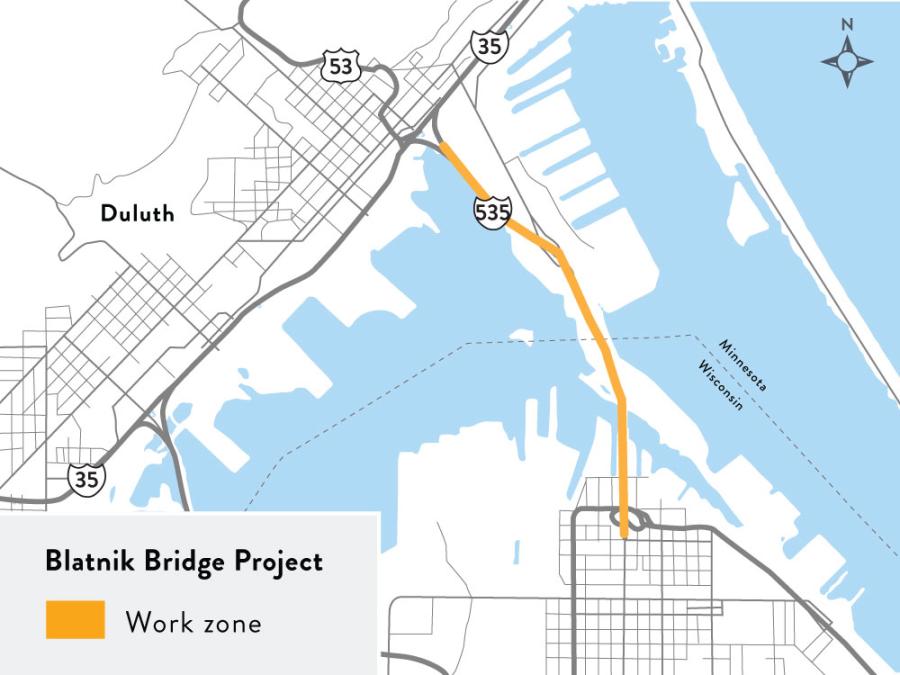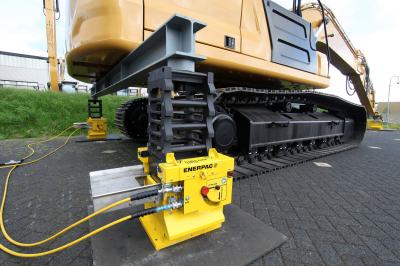Map courtesy of the Office of Gov. Tony Evers
Gov. Tony Evers, together with Minnesota Gov. Tim Walz, announced Dec. 4 their state transportation agencies have requested more than $1 billion in federal funding through the U.S. Department of Transportation's (USDOT) Bridge Investment Program (BIP) to replace the aging John A. Blatnik Bridge between Superior, Wis., and Duluth, Minn.
"For more than 60 years, the Blatnik Bridge has been a vital link for our communities and businesses. But as the bridge reaches the end of its service life, its condition continues to deteriorate — and it's time for us to exhaust every opportunity to replace this crucial connector with a safer, more efficient and more reliable structure for the next generation," said Evers. "This submittal is a major step forward for our two states, and I look forward to continuing to work with Governor Walz and our partners in Minnesota and our federal partners to build the 21st-century infrastructure the people of our states deserve."
"The Blatnik Bridge is a critical connection point for transportation and commerce between Minnesota and Wisconsin — and it needs an upgrade," said Walz. "I'm proud to partner with Wisconsin Governor Tony Evers as we urge our federal partners to support this project that will foster regional economic growth, bolster our national supply chains and strengthen the reliability of our transportation network that serves hundreds of communities between our states."
Earlier this year, Evers signed the 2023-25 biennial budget, which authorized $47.2 million in funding and $352.8 million in transportation fund-supported, general obligation bonding authority to secure sufficient state support for the project. Additionally, due to the efforts of U.S. Sen. Tammy Baldwin (D-Wisconsin), last year, the federal omnibus spending bill signed by President Joe Biden included more than $255 million to support dozens of projects throughout Wisconsin, including $7.5 million for the Blatnik Bridge. This financial commitment has been essential to ensuring the state can be competitive in applying for additional federal support for the project.
"I voted for the Bipartisan Infrastructure Law to bring federal funding home to Wisconsin to repair our roads and bridges — like the Blatnik Bridge," said Baldwin. "The bridge is a crucial link between Minnesota and Wisconsin, supporting our supply chain, commuters and visitors. I am proud to support Wisconsin's application for funding to replace the Blatnik Bridge and invest in our economy, safety and future."
This is the second federal grant jointly sought by the states of Wisconsin and Minnesota to replace this critical Midwest transportation structure. Earlier this year, Evers and Walz announced a federal grant application for more than $1 billion through the USDOT's Multimodal Project Discretionary Grant (MPDG) program. Both MPDG and BIP are grant programs that are part of the federal Bipartisan Infrastructure Law (BIL).
Built in 1961, the Blatnik Bridge has served as an essential link between Superior and Duluth via Interstate 535 and US 53. Jointly owned and operated by the Wisconsin Department of Transportation (WisDOT) and the Minnesota Department of Transportation (MnDOT), the bridge is an important freight and commercial connector. More than 33,000 vehicles cross the bridge each day, including commuters and visitors. Each year, more than 265,000 trucks transporting nearly $4 billion in goods pass over the Blatnik Bridge. Many businesses across the upper Midwest rely on the bridge to reach the Port of Duluth-Superior, the largest United States' port on the Great Lakes. The bridge also is one of the largest marine links for trade with Canada, the top trade partner of Wisconsin, Minnesota and the United States.
Over the years, the Blatnik Bridge has had significant structural deterioration. As a result, the bridge has needed to be load posted for 40 tons since 2019, can no longer carry overweight freight load, and is at risk for complete closure by 2030. The total project cost to tear down the existing bridge and build a new bridge in its footprint is estimated at $1.8 billion. Each state committed $400 million toward the project this year and plans to seek additional federal funds through other sources, including BIP and MPDG program, to get the project over the finish line.
"Our commitment to improving safety and the long-term sustainability of our bridges is unwavering. I know our partners at MnDOT share this sentiment," said WisDOT Secretary Craig Thompson. "These grant applications and deepening shows of support — from local communities and elected officials in both states — demonstrate how important this project is and why we must act with urgency."
Since the MPDG grant submission in August, support to replace the Blatnik Bridge has grown. A letter of support signed by nine elected officials in Wisconsin and Minnesota, including Sen. Baldwin, was sent to President Biden in September. The letter urges federal action to replace the bridge, underscoring that it is an essential economic engine in the region and a key connection in the global supply chain.
WisDOT and MnDOT previously submitted the Blatnik Bridge project to BIP in 2022, and although the bridge was not selected for funding in that round, the project team received valuable feedback from the USDOT and made significant improvements to the current BIP grant application. For example, the project team worked with the USDOT's Federal Highway Administration to complete the cost schedule risk assessment, as well as refined and made clarifications to the benefit-cost analysis to better present the project.
The goal of the project is to improve overall operational performance, fix significant structural deterioration, address safety concerns, and enhance vehicle and freight mobility. Plans will follow the same alignment as the current bridge, and the preferred alternative would add a multi-use path for pedestrians and bicycles.
The federal BIL funding will be allocated to a substantial portion of the project's budget and enable an accelerated schedule to complete the project faster. Design work for the project, which would determine specifications and shape the total cost of the project, is anticipated to begin in 2024. Once a final design is selected, construction could begin as early as late 2025 if full funding is secured.
Today's top stories















